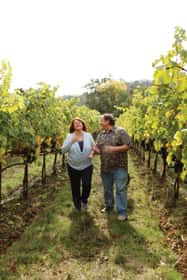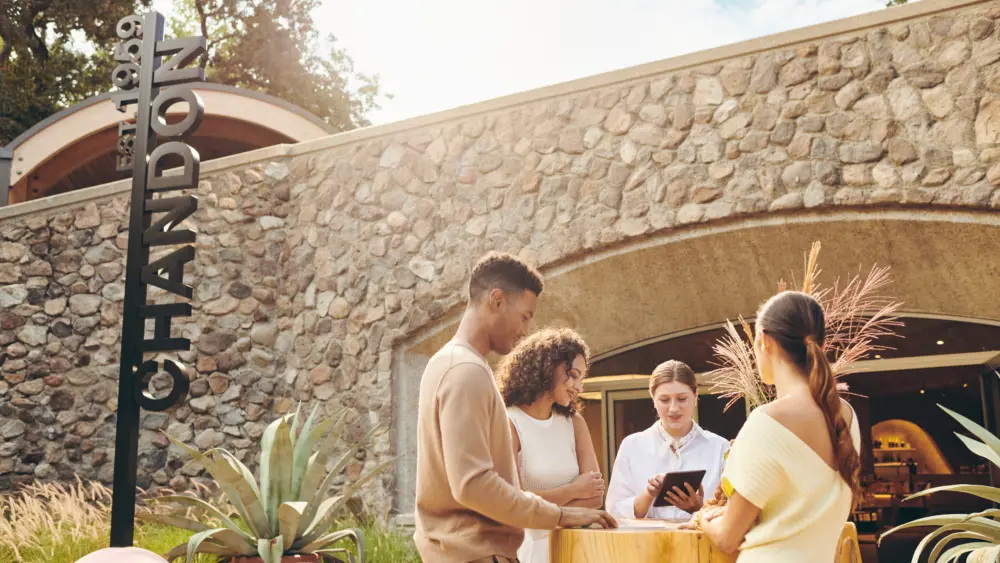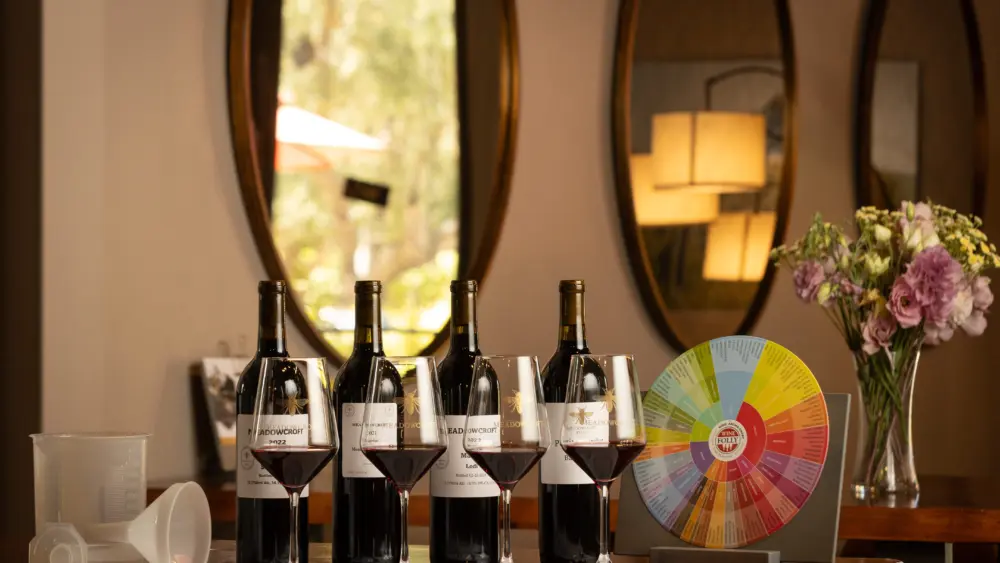Glen Ellen, CA 95442
(707) 933-2800
Tasting fees: $25 per person
Did You Know?
The Lasseter family crest, created by John Lasseter, is a bee (John), a rose (Nancy) and five grapes (one for each son).

After delivering their homemade vino to friends for several Christmases, John and Nancy decided it was time to go pro. In 2002, they found a historic (but in need of repair) winery and vineyard property near the town of Glen Ellen and set about bringing their vision to life. Their love of French wines, particularly Rhone- and Bordeaux-style blends, guided the work.
“The family chose this place because the soil so closely resembles the areas of France where their favorite wines come from,” we’re told as we stand in the Cabernet Franc vineyard on a hot August morning. The low, rolling terrain, known locally as the “Glen Ellen mounds [or moguls],” is the result of tectonic movement, and an ancient creek bed is responsible for the ground’s “cobbly” nature: “It’s great for vineyards.”
The 95-acre, certified organic property includes 40 acres of vineyards ranging in age from newly planted to old vine Zinfandel planted almost a century ago. All wines are made from estate fruit.
The winery/tasting room structure occupies the original winery “footprint,” but is all new as of 2011. It’s nestled into a low hillside and constructed of wood and stone. When you enter, you’re surrounded by dark wood and rich textures, but the expansive windows (with a vineyard view) and clean, modern lines make the space welcoming and elegant. Local artist Dennis Ziemienski created all the artwork for the wine labels, based on the story of each wine or reflecting a vista from the property.
The winery welcomes up to 10 guests at a time, by appointment only, and will combine groups, if necessary, to accommodate as many requests as possible. Visitors will sample Lasseter wines, each paired with delightful local cheese (and, depending on the flavor profile, perhaps a bit more). Our host described each wine—its blend, name translation (they’re all French words), intent and flavor profile—along with the delectable bits and bites.
Starting with the 2012 Enjoué (“joyful,” “playful”), a Rosé blend of Syrah, Grenache and Mouvedre, she shares the family’s vision: “All Lasseter wines are blends,” she says, “because we think they’re often more approachable.”
The Rosé is subtle and light, the result, we’re told, of harvesting the grapes early. “A lot of winemakers make Rosé from the juice they drain from their red wine to make it more robust,” we’re told. “Here, we have a first harvest that’s used exclusively for Rosé. We go back about three weeks later to harvest for the red wine. The thinning of the vines lets the fruit become deeper and more robust on the vine before we harvest for the red.”
When the family purchased this land, it contained a nearly 100-year-old Zinfandel vineyard (actually, a field blend in the Italian tradition). “At first, the Lasseters weren’t sure they wanted to make Zinfandel, so they only made two barrels the first year.” But it’s since become a family—and winery—favorite. The 2011 L’Ame du Sage (“soul of the wise man”) is deep and delicious, with peppery spice and ripe berries.
Next, we previewed the 2010 Paysage (“landscape painting”), a Bordeaux-style blend that leads with Merlot (savory, ripe plum) and would be terrific with a hearty winter meal. The Malbec-based 2010 Amoureux (“lovers”) is named to reflect the Lasseters’ romance with wine (the couple first tasted Malbec while honeymooning in Sonoma); it has blueberry, earthy spices and a bit of vanilla.
We try a bit of 2011 Chemin de Fer (“railroad”), the “big brother of the Rosé.” It’s the wine made after the extra hangtime and second harvest and wow, what a difference. I really enjoyed comparing the two side-by-side. You could definitely taste the connectedness, but the end results were distinct. It would be too hard to choose between them.
As we’re winding down the tasting, sipping what remains and nibbling leftover cheese, charcuterie and chocolate (yum!), winemaker Julia Iantosca stops in. She’s been in the vineyards and lab already, sampling grapes and readying for the coming harvest. She even brings a few just-picked varietals for us to try, which is enlightening. The differences are evident—tannins, sweetness, color, berry size and cluster tightness—and make the art of blending even more impressive.
“[Blending] gives a winemaker a lot of latitude to develop a style,” she says. “In the Bordeaux and Rhome regions of France, the vision is a blended wine. Each winery has a ‘house style’ that’s reflected vintage to vintage.
“I make wine consistent with the Lasseter Winery style and personality.”




